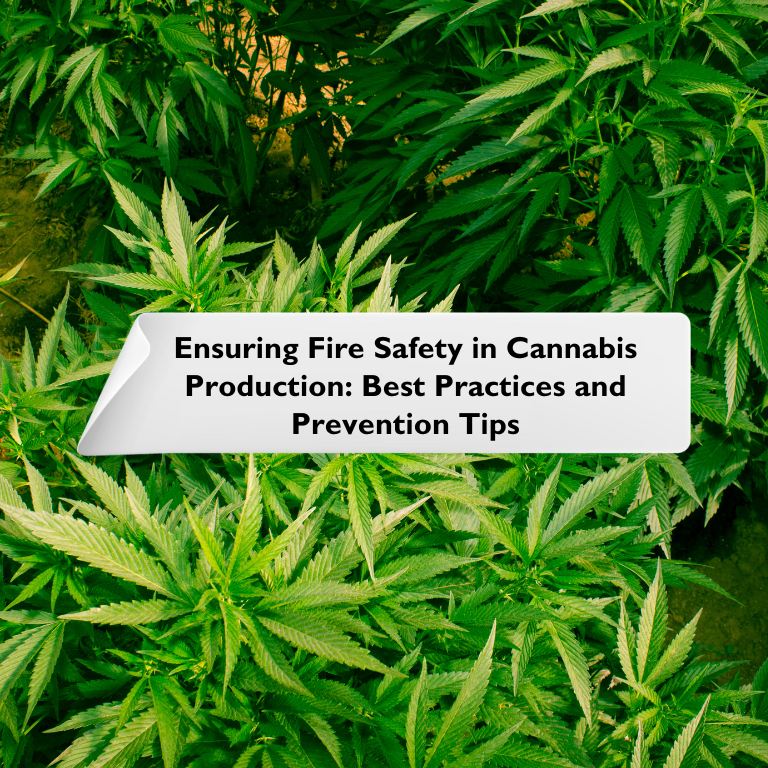Critical Fire Safety Measures for Cannabis Production Facilities

Cannabis production facilities, like any industrial operation, face significant fire risks. Given the nature of the materials involved and the processes used, implementing robust fire safety and prevention measures is crucial. Ensuring the safety of employees, protecting valuable crops, and maintaining compliance with regulatory standards are top priorities. This article outlines the best practices for fire safety in cannabis production facilities, focusing on proper electrical wiring, safe storage protocols for flammable materials, and thorough staff training.
Understanding Fire Risks in Cannabis Production
Cannabis production facilities encompass a range of activities, from cultivation to processing, all of which can present unique fire hazards. Understanding these risks is the first step in developing effective prevention strategies.
Common Fire Hazards
- Electrical Systems: Faulty wiring and overloaded circuits can lead to electrical fires.
- Flammable Materials: Solvents used in extraction processes and other flammable chemicals pose significant risks.
- Heating Equipment: High-powered lights and heating systems used in cultivation can be potential ignition sources.
- Dust Accumulation: Organic dust from cannabis plants can be highly combustible under certain conditions.
Importance of Electrical Safety
Electrical systems are integral to cannabis production, powering lights, HVAC systems, and various equipment. Ensuring these systems are safe and compliant with standards is crucial to preventing electrical fires.
Best Practices for Electrical Wiring
- Hire Licensed Electricians: Only qualified professionals should handle electrical installations and repairs to ensure compliance with local codes and standards.
- Regular Inspections: Schedule periodic inspections of all electrical systems to identify and rectify potential hazards before they escalate.
- Avoid Overloading Circuits: Distribute electrical loads evenly and avoid overloading circuits to prevent overheating and potential fires.
- Use Quality Components: Invest in high-quality electrical components and equipment to reduce the risk of failures and short circuits.
Implementing Ground Fault Circuit Interrupters (GFCIs)
GFCIs are crucial in preventing electrical shocks and fires, especially in areas where moisture is present. Install GFCIs in all relevant locations within the facility.
Storage Protocols for Flammable Materials
Flammable materials, including solvents and chemicals used in the extraction and processing of cannabis, pose a significant fire risk if not handled and stored properly.
Best Practices for Storage
- Designated Storage Areas: Store flammable materials in designated, well-ventilated areas away from ignition sources.
- Proper Containers: Use approved containers for storing flammable liquids and chemicals to prevent leaks and spills.
- Labeling and Documentation: Clearly label all containers and maintain accurate records of the quantities and types of materials stored.
- Safety Data Sheets (SDS): Ensure that Safety Data Sheets for all flammable materials are readily accessible to staff.
Ventilation and Fire Suppression
Install proper ventilation systems to disperse any vapors from flammable materials. Additionally, equip storage areas with appropriate fire suppression systems, such as sprinklers or chemical extinguishers.
Staff Training and Emergency Preparedness
Importance of Training: Educating staff about fire risks and safety protocols is essential for effective fire prevention and response. Well-trained employees can identify potential hazards and take appropriate actions to mitigate risks.
Comprehensive Training Programs
- Fire Safety Training: Provide regular fire safety training sessions covering the identification of hazards, proper use of fire extinguishers, and evacuation procedures.
- Emergency Drills: Conduct regular fire drills to ensure all employees are familiar with evacuation routes and procedures.
- Handling Flammable Materials: Train staff on the safe handling, storage, and disposal of flammable materials to minimize risks.
Establishing an Emergency Response Plan
Develop a detailed emergency response plan outlining procedures for fire detection, reporting, evacuation, and communication. Ensure all staff are familiar with this plan and conduct regular reviews and updates.
Implementing Advanced Fire Detection and Suppression Systems
Fire Detection Systems: Early detection is key to preventing small fires from becoming major incidents. Install advanced fire detection systems, including smoke detectors, heat sensors, and flame detectors, throughout the facility.
Fire Suppression Systems
- Automatic Sprinklers: Install automatic sprinkler systems to quickly control and extinguish fires.
- Chemical Extinguishers: Place chemical fire extinguishers in strategic locations, particularly near areas with flammable materials.
- Suppression Systems for Equipment: Equip high-risk equipment, such as extraction machines, with dedicated fire suppression systems.
Regular Maintenance and Testing: Ensure all fire detection and suppression systems are regularly maintained and tested to guarantee their functionality in an emergency.
Regulatory Compliance and Best Practices
Cannabis production facilities must comply with various local, state, and federal regulations concerning fire safety. Familiarize yourself with these regulations and ensure your facility meets all requirements.
Regular Audits and Inspections: Conduct regular audits and inspections to identify potential fire hazards and ensure compliance with safety standards. Address any deficiencies promptly.
Continuous Improvement: Fire safety is an ongoing process. Continuously seek ways to improve safety measures, update training programs, and invest in new technologies to enhance fire prevention and response capabilities.
Fire safety in cannabis production facilities is a critical concern that requires a comprehensive and proactive approach. By implementing proper electrical wiring practices, adhering to safe storage protocols for flammable materials, and providing thorough staff training, facilities can significantly reduce the risk of fire. Advanced fire detection and suppression systems, along with a commitment to regulatory compliance and continuous improvement, further enhance safety. Protecting your facility, employees, and valuable crops from fire hazards is not just a regulatory requirement but a moral imperative. Prioritize fire safety to ensure the success and sustainability of your cannabis production operation.











